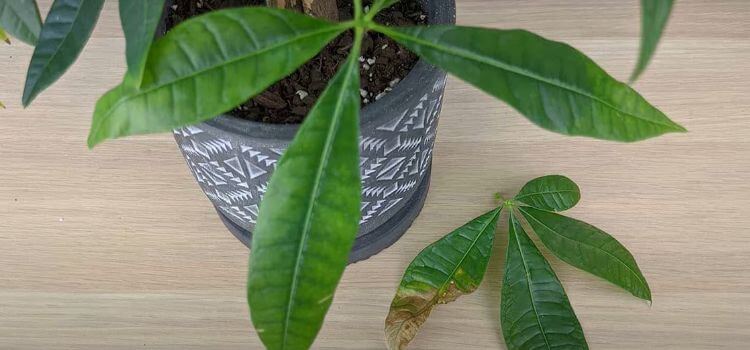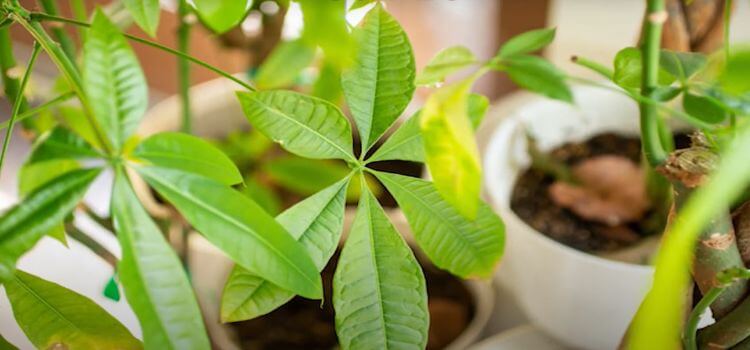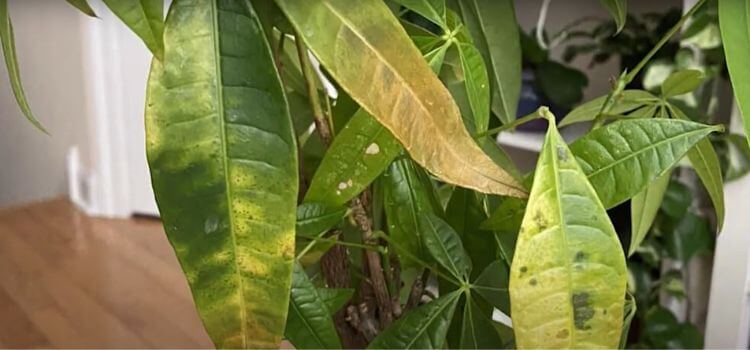As an Amazon Associate, I earn from qualifying purchases.
Your money tree might die from overwatering, poor drainage, or insufficient light. Address these issues to revive it.
The money tree, scientifically known as Pachira aquatica, is a captivating houseplant with its distinctive braided trunk and lush green leaves. While it can adapt to most indoor environments, it still requires proper care to maintain its health and beauty. Overwatering can lead to root rot, while poor drainage hampers moisture control, making it essential to strike the right balance.
Insufficient light can also hinder its growth. To ensure your money tree flourishes, balance watering habits, provide adequate drainage, and place it in an area with indirect sunlight. Regularly check for pests and prune dead leaves to keep them vibrant. With the proper care, your money tree can thrive and bring a touch of nature indoors.
Common Reasons For Money Tree Decline
Is your money tree looking less lively? Several factors could be the culprits behind its decline. Understanding these common reasons can help you nurse it back to health.
Improper Watering
Watering issues are a primary cause of money tree decline. These plants thrive on a balanced watering schedule. Both overwatering and underwatering can harm them.
- Overwatering: Too much water leads to root rot. The roots sit in soggy soil and start to decay.
- Underwatering: Not enough water causes the leaves to wilt and dry out. The plant becomes stressed and weak.
To avoid these problems, follow these steps:
- Check the soil moisture before watering.
- Water the plant thoroughly when the top inch of soil feels dry.
- Ensure the pot has good drainage to prevent water from sitting at the bottom.

Inadequate Light
Light conditions play a crucial role in the health of your money tree. They need bright, indirect light to thrive.
| Light Condition | Effect on Plant |
|---|---|
| Too Much Direct Sunlight | Leaves can scorch and turn brown. |
| Too Little Light | Leaves become yellow and fall off. |
To provide the right light:
- Place your money tree near a window with filtered light.
- Avoid placing it in direct sunlight for extended periods.
- If natural light is insufficient, consider using a grow light.
Signs Of A Dying Money Tree
Understanding the signs of a dying money tree is crucial for any plant owner. Recognizing these signs can help you take action and save your beloved plant. Below are the key indicators that your money tree might be in trouble.
Yellowing Leaves
One of the first signs of a dying money tree is yellowing leaves. This happens due to overwatering, underwatering, or poor soil conditions. When leaves turn yellow, the plant is stressed and needs immediate attention. Ensure the soil drains well and is manageable.
| Cause | Solution |
|---|---|
| Overwatering | Check soil moisture levels before watering again. |
| Underwatering | Water the plant thoroughly, allowing the soil to dry out between waterings. |
| Poor Soil | Use a well-draining potting mix to improve soil conditions. |
Leaf Drop
Leaf drop is another common sign that your money tree is in distress. Sudden changes in temperature or light, overwatering, or pest infestations can cause leaf drop, which indicates that the plant is struggling to maintain its health.
- Temperature Changes: Keep your money tree in a stable environment.
- Light Conditions: Ensure the plant receives indirect sunlight.
- Pest Infestations: Check for pests and treat them accordingly.
By recognizing these signs early, you can take steps to revive your money tree. Pay attention to yellowing leaves and leaf drops, and adjust care routines as needed.
Reviving A Dying Money Tree
Is your money tree looking sad? Yellow leaves, drooping stems, and poor growth are signs of trouble. Don’t worry! You can save your beloved plant with a few simple steps.
Adjusting Watering Schedule
Over-watering and under-watering are common problems. Water your money tree only when the top inch of soil is dry. Use a moisture meter to check the soil. Avoid letting the pot sit in water. Drain excess water to prevent root rot.
Follow these steps to adjust your watering schedule:
- Check the soil moisture once a week.
- Water thoroughly but infrequently.
- Ensure the pot has drainage holes.
- Use room temperature water.
Finding The Right Spot
Money trees need the right amount of light. Place your money tree in bright, indirect sunlight. Avoid direct sunlight as it can burn the leaves. Low light can cause slow growth and yellowing leaves.
Consider these tips for finding the perfect spot:
- Avoid placing near drafty windows or doors.
- Keep away from heating vents and air conditioners.
- Rotate the plant every few weeks for even growth.
- Use a sheer curtain to filter direct sunlight.
Following these tips, you can revive your money tree and enjoy its beauty for years.

Pests And Diseases
Is your Money Tree looking less vibrant? Pests and diseases could be the culprits. These issues can quickly turn a thriving plant into a drooping mess. Knowing how to identify and treat these problems can save your plant.
Identifying Common Pests
Common pests can wreak havoc on your Money Tree. Spider mites, mealybugs, and scale insects are the usual suspects. Look for tiny webs, white cottony spots, or minor, hard bumps on the leaves and stems.
- Spider Mites: Tiny red or black dots. They often leave delicate webs.
- Mealybugs: White, cotton-like spots on leaves and stems.
- Scale Insects: Small, hard bumps on leaves and stems.
Dealing With Fungal Infections
Fungal infections can be deadly for your Money Tree. Root rot and leaf spot are the most common types. Root rot often occurs from overwatering, and leaf spot is usually due to poor air circulation and high humidity.
| Fungal Infection | Symptoms | Prevention |
|---|---|---|
| Root Rot | Yellowing leaves, mushy roots | Ensure proper drainage, avoid overwatering |
| Leaf Spot | Brown or black spots on leaves | Improve air circulation, reduce humidity |
To treat fungal infections:
- Use a fungicide.
- Remove any affected leaves.
- Improve air circulation around your plant.
- Let the soil dry out between waterings.
Pruning And Maintenance Tips
Keeping your Money Tree healthy requires regular pruning and maintenance. Proper care can prevent issues like dead branches and dusty leaves. Below are some essential tips to help you maintain your Money Tree’s health.
Trimming Dead Branches
Dead branches can drain the energy of your Money Tree’s healthy parts. Trimming them helps the tree thrive.
- Identify dead branches: Look for brown, brittle, or leafless branches.
- Use clean, sharp tools: Sharp scissors or pruning shears work best.
- Cut at an angle: This helps the tree heal faster. Cut close to the main branch but avoid damaging it.
Regular trimming can also shape your tree, making it look more attractive. A well-trimmed Money Tree is a happy tree.
Cleaning Leaves
Dusty leaves can block sunlight, which your Money Tree needs to grow. Cleaning leaves is simple and effective.
- Use a damp cloth: Gently wipe each leaf with a soft, wet cloth.
- Support the leaf: Hold the leaf in one hand while cleaning to avoid damage.
- Check for pests: Look for tiny insects or sticky residue. If found, treat with insecticidal soap.
Clean leaves can breathe better and absorb more sunlight. This helps your Money Tree stay green and vibrant.
Regular pruning and cleaning ensure that your money tree remains healthy and beautiful. Follow these tips for a thriving Money Tree.
Nutritional Needs Of A Money Tree
A healthy Money Tree requires balanced nutrition. This ensures vibrant growth and longevity. Understanding its nutritional needs helps prevent common issues like yellowing leaves or stunted growth.
Fertilizer Requirements
Money Trees need specific types of fertilizer. Use a balanced, water-soluble fertilizer. Apply it once a month during the growing season, and avoid fertilizing in winter.
Here’s a simple table for guidance:
| Season | Frequency | Type |
|---|---|---|
| Spring | Once a month | Balanced, water-soluble |
| Summer | Once a month | Balanced, water-soluble |
| Fall | Once a month | Balanced, water-soluble |
| Winter | Avoid fertilizing | None |
Balancing Nutrients
Proper nutrient balance is critical for a thriving Money Tree. Here are the essential nutrients:
- Nitrogen (N): Promotes healthy leaf growth.
- Phosphorus (P): Supports strong root development.
- Potassium (K): Enhances overall plant vigour.
Ensure your fertilizer contains these nutrients in equal parts. Too much of one nutrient can harm the plant. Always follow the fertilizer’s instructions for the best results.
Watch out for signs of nutrient imbalance. Yellowing leaves may indicate a nitrogen deficiency. Slow growth can signal a lack of phosphorus. Weak stems mean low potassium levels.
Use this checklist to help balance nutrients:
- Check the fertilizer label for the N-P-K ratio.
- Apply fertilizer as directed.
- Monitor plant health regularly.
- Adjust the feeding schedule if needed.
Keeping these tips in mind ensures your Money Tree stays healthy and vibrant.
Preventive Care To Keep Your Money Tree Healthy
Keeping your Money Tree healthy requires proactive care. Regular attention can prevent common issues and ensure your plant thrives. Here are some essential practices to help your Money Tree stay in top condition.
Regular Inspections
Inspect your Money Tree every week. Check for signs of pests like aphids or spider mites. Look for yellowing leaves, which can indicate overwatering or nutrient deficiencies.
Examine the soil for moisture levels. The soil should be moist but not soggy. If it feels dry, it’s time to water your plant. Early detection of problems can save your Money Tree from severe damage.
Creating A Supportive Environment
Your Money Tree needs a supportive environment to thrive. Please place it in a spot with bright, indirect light. Direct sunlight can scorch the leaves.
Maintain a temperature between 65°F and 80°F. Avoid placing your plant near drafts or heat sources. Consistent temperature helps keep your Money Tree healthy.
Humidity is also crucial. Money Trees prefer humid conditions. To increase humidity, use a humidifier or place a water tray nearby.
Follow these preventive care tips to keep your Money Tree healthy and vibrant.
When To Consider Repotting
Is your money tree looking sad and wilted? The problem might be its pot. Repotting can give your plant a fresh start. This process helps by giving roots more space and fresh soil. Knowing when to report is crucial in saving your money tree.
Checking Root Boundness
Root boundness means roots have no more space to grow. This happens when the pot is too small. Signs of root boundness include roots circling the bottom of the pot, soil drying out quickly, and yellowing leaves.
To check, gently remove the plant from its pot. Look at the roots. Are they tightly packed or circling? If yes, your money tree needs repotting. A root-bound plant can’t absorb nutrients well.
The Right Potting Mix
A good potting mix is crucial for a healthy money tree. Use a mix that drains well. This prevents root rot. A blend of peat moss, perlite, and sand works well.
Avoid heavy soils that hold too much water. They can suffocate roots. Always use fresh potting mix when repotting, as old soil may lack nutrients.
Here is a simple mix recipe:
| Ingredient | Amount |
|---|---|
| Peat Moss | 2 parts |
| Perlite | 1 part |
| Sand | 1 part |
Mix these ingredients well before use to ensure even distribution. Your money tree will thrive in this mix.
Frequently Asked Questions
Water it properly to save a dying money tree, ensuring the soil isn’t too dry or soggy. Provide bright, indirect sunlight. Check for pests and treat if needed. Prune dead leaves and stems. Ensure well-draining soil and a suitable pot.
An overwatered money tree shows yellowing leaves, mushy stems, and root rot. The soil may appear waterlogged.
An unhealthy money tree has yellowing leaves, wilting, and brown spots. It may also show stunted growth and root rot.
Yes, money tree leaves can grow back. Ensure proper care, like adequate light, water, and humidity, and trim dead leaves.
Conclusion
Caring for a Money Tree requires attention to light, water, and soil conditions. Ensure proper care to keep it thriving. Regularly check for pests and overwatering. Remember, a healthy environment promotes growth. Keep these tips in mind, and your Money Tree will flourish beautifully.
Happy gardening!

